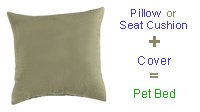23rd Sep 2011
Dog Beds, Cat Beds, Pet Beds - Economical and Healthy
 Many dog and cat beds are commercially available. But, quite a few that we’ve looked at are too bulky to wash on a regular enough basis to keep them sanitary and healthy, and some are simply too bulky to throw into the washer in the first place. Others are made from materials we don’t consider healthy, including synthetic or nanoparticle-containing so-called ‘dirt- or liquid-repellent’ materials. Moreover, many beds that are made from healthy organic materials are also too bulky to keep clean.
Many dog and cat beds are commercially available. But, quite a few that we’ve looked at are too bulky to wash on a regular enough basis to keep them sanitary and healthy, and some are simply too bulky to throw into the washer in the first place. Others are made from materials we don’t consider healthy, including synthetic or nanoparticle-containing so-called ‘dirt- or liquid-repellent’ materials. Moreover, many beds that are made from healthy organic materials are also too bulky to keep clean.
We’ve found a simple solution (we like to call it the “econodog” or “econocat” bed) that is not only easily washed, versatile, and comfortable, but also economical: quite simply, a good quality pillow or seat cushion made from natural materials that’s covered with a pillow case.
You can easily wash all components. If the pillow case is too large for the pillow, you can easily adjust its size with a few simple stitches, or just fold the excess fabric under the pillow itself. You can repurpose or reuse what you have or buy something new or second-hand (in both cases, make sure you wash the pillow and/or pillow case before letting your pet use it/them). This way you can be sure of the quality and safety of the material your animal sleeps on, keep his or her bed safe and clean, and stay well within your budget. If your pet needs more or less support, you can easily modify the bed to his or her specific requirements. The bed components can be easily adjusted to your pet’s size. And, since its cover can be changed regularly, the bed need never become a boring piece of furniture. So, to sum up: keep it safe by keeping it simple!
 Many dog and cat beds are commercially available. But, quite a few that we’ve looked at are too bulky to wash on a regular enough basis to keep them sanitary and healthy, and some are simply too bulky to throw into the washer in the first place. Others are made from materials we don’t consider healthy, including synthetic or nanoparticle-containing so-called ‘dirt- or liquid-repellent’ materials. Moreover, many beds that are made from healthy organic materials are also too bulky to keep clean.
Many dog and cat beds are commercially available. But, quite a few that we’ve looked at are too bulky to wash on a regular enough basis to keep them sanitary and healthy, and some are simply too bulky to throw into the washer in the first place. Others are made from materials we don’t consider healthy, including synthetic or nanoparticle-containing so-called ‘dirt- or liquid-repellent’ materials. Moreover, many beds that are made from healthy organic materials are also too bulky to keep clean.
We’ve found a simple solution (we like to call it the “econodog” or “econocat” bed) that is not only easily washed, versatile, and comfortable, but also economical: quite simply, a good quality pillow or seat cushion made from natural materials that’s covered with a pillow case.
You can easily wash all components. If the pillow case is too large for the pillow, you can easily adjust its size with a few simple stitches, or just fold the excess fabric under the pillow itself. You can repurpose or reuse what you have or buy something new or second-hand (in both cases, make sure you wash the pillow and/or pillow case before letting your pet use it/them). This way you can be sure of the quality and safety of the material your animal sleeps on, keep his or her bed safe and clean, and stay well within your budget. If your pet needs more or less support, you can easily modify the bed to his or her specific requirements. The bed components can be easily adjusted to your pet’s size. And, since its cover can be changed regularly, the bed need never become a boring piece of furniture. So, to sum up: keep it safe by keeping it simple!
 Posted by Heidi Junger, PhD under
Posted by Heidi Junger, PhD under  Home Remedies & News Bits
Home Remedies & News Bits  Comments Off
Comments Off




